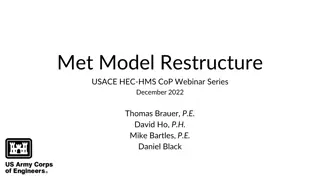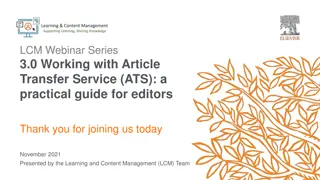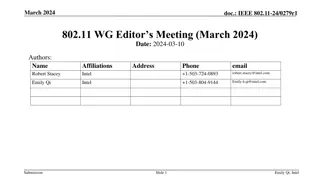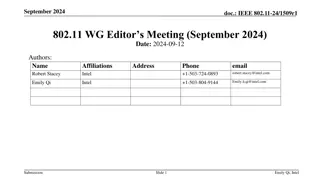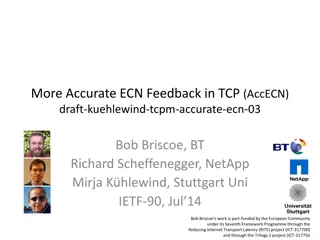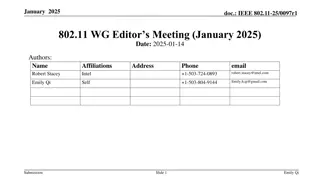
Advanced Network Protocol Enhancements
Explore the upcoming features for the next editor's draft version, including incorporating new timers, enhancing state machines, updating status parameters, and addressing historical inconsistencies. Dive into detailed plans for the Mux state machine, ISS status parameters, and Aggregator port status, aiming to streamline operations and improve overall efficiency in network management.
Download Presentation

Please find below an Image/Link to download the presentation.
The content on the website is provided AS IS for your information and personal use only. It may not be sold, licensed, or shared on other websites without obtaining consent from the author. If you encounter any issues during the download, it is possible that the publisher has removed the file from their server.
You are allowed to download the files provided on this website for personal or commercial use, subject to the condition that they are used lawfully. All files are the property of their respective owners.
The content on the website is provided AS IS for your information and personal use only. It may not be sold, licensed, or shared on other websites without obtaining consent from the author.
E N D
Presentation Transcript
Plans for next Editors draft Version 1 Stephen Haddock January 19, 2017 1
Selected plans for AX-Rev-d0.1 1. (Re-)Incorporate Wait-to-Restore timer 2. Mick s MUX state machine 3. ISS Status parameters 4. actorAdminX and actorOperX variables 5. Merge Verification and Receive Long LACPDU state machines into the LACP Receive state machine Which would fix the setting of default values for Conversation Sensitive Collection and Distribution 6. Start work on clause 9 (DRNI)
Mux state machine Propose to accept Mick s Mux state diagram Fig 4 of http://www.ieee802.org/1/files/public/docs2017/ax-rev-seaman-wait-to- restore-0117-v01.pdf 1. Incorporates WTR Timer (adding ATTACHED_WTR state) 2. Subsumes WAITING state into DETACHED state Makes wait-to-attach timer responsibility of Selection Logic 3. Adds ATTACH state and mux_attach variable Would prefer to name the variable port_attached or simply attached 4. Provides direct transitions for cases where current Mux machine ripples through several states with no change in input variables 5. Consolidate independent-control and coupled-control diagrams
ISS Status Parameters History 1. 802.3ad-2000 (clause 43) placed the Link Aggregation Sublayer between MAC Control and MAC Client sublayers, and included status parameters consistent with 802.3 layer architecture and naming. 802.1AX-2008 made Link Aggregation a stand alone 802.1 standard, with minor changes to make sublayers MAC type independent. 802.1AX-2014 placed the Link Aggregation Sublayer between instances of the Internal Sublayer Service (ISS) to make it consistent with 802.1 architecture (and allow things like CFM shims around the Link Aggregation sublayer). Made description of the parser/mux elements consistent with ISS Provided text to connect the 802.3 style status parameters to the ISS Status Still a few gaps and sources of confusion 2. 3.
Aggregation Port Status parameters ISS has MAC_Enabled and MAC_Operational Link Aggregation Sublayer does not use the MAC_Enabled parameter does use the MAC_Operational parameter but calls it port_enabled (Arghh !) The name dates back to the dark ages when 802.3 MACs had no idea if they were connected to anything or not and did not distinguish between being enabled and being operational. Propose renaming this to port_operational Does not affect any managed objects or the MIB.
Aggregator Port Status parameters The ISS MAC_Enabled and MAC_Operational are variables associated with the service providing the SAP But if look in 6.4.6 Variables associated with each Aggregator you won t find anything looking like enabled and operational status parameters for the Aggregator Port. The Aggregator managed objects (6.3.1.1.13 and 6.3.1.1.14) include aAggAdminState (Read/Write with values up/down) and aAggOperState (Read-only with values up/down) that have (almost exactly) equivalent semantics to MAC_Enabled and MAC_Operational. 802.1AX-2014 added section 6.3.12 MAC_Operational Status that describes how the managed objects relate to the Aggregator Port MAC_Operational value, but no mention of MAC_Enabled with a few inconsistencies in the MAC_Operational description.
Aggregator Port Status proposal Add Aggregator_Enabled and Aggregator_Operational parameters to 6.4.6. Modify section 6.3.12 to use these terms Rename the managed objects to use 802.1AC ISS style names and values instead of 802.3 sub-layer interface style Would require deprecating old MIB objects and adding new, but we ll certainly have other MIB updates anyway Don t have to do this, but I think it would reduce confusion. Delete the Aggregator Receive_State and Transmit_State These are not used anywhere, or available to management. Only reference to them is in 6.3.12 and is wrong.
actorAdminX/actorOperX variables There are several cases where actorAdmin and actorOper variants of a variable are present without a description of when/how the Admin value affects the Oper value, and without a clear specification of the side effects when writing a new Admin value
Merge CSCD Rx state machines into the LACP Receive state machine 802.1AX-2014 went to extraordinary lengths 1. not to modify the description of LACP v1 functionality, and 2. to keep any new LACP v2 functionality completely separate. This was generally a noble objective, but in some cases led to unreasonable results Having a single received LACPDU be parsed and processed by three separate state machines is a prime example. Not incorporating the Verification machine into the basic receive machine prevents correct handling of recordDefault functions.

